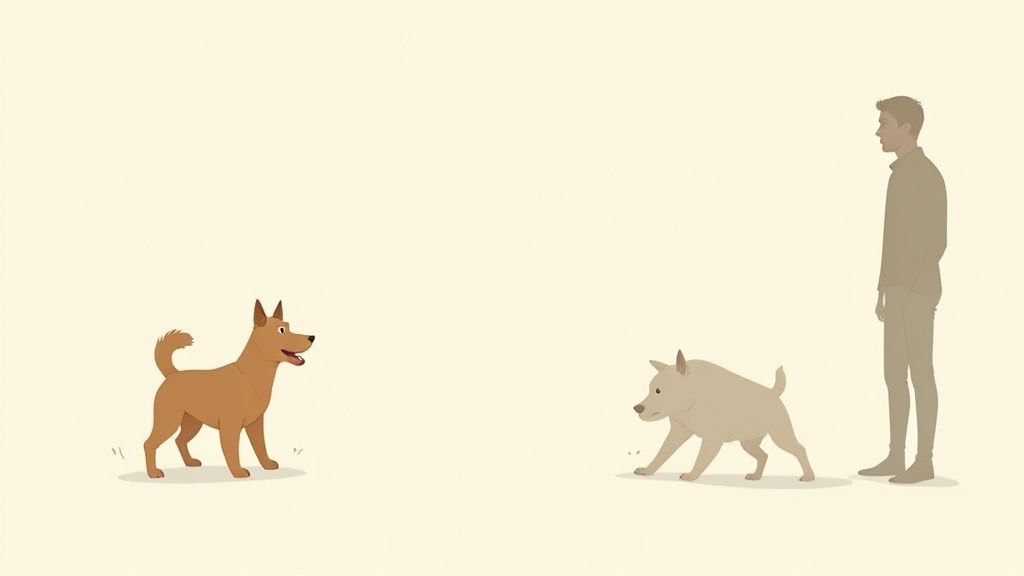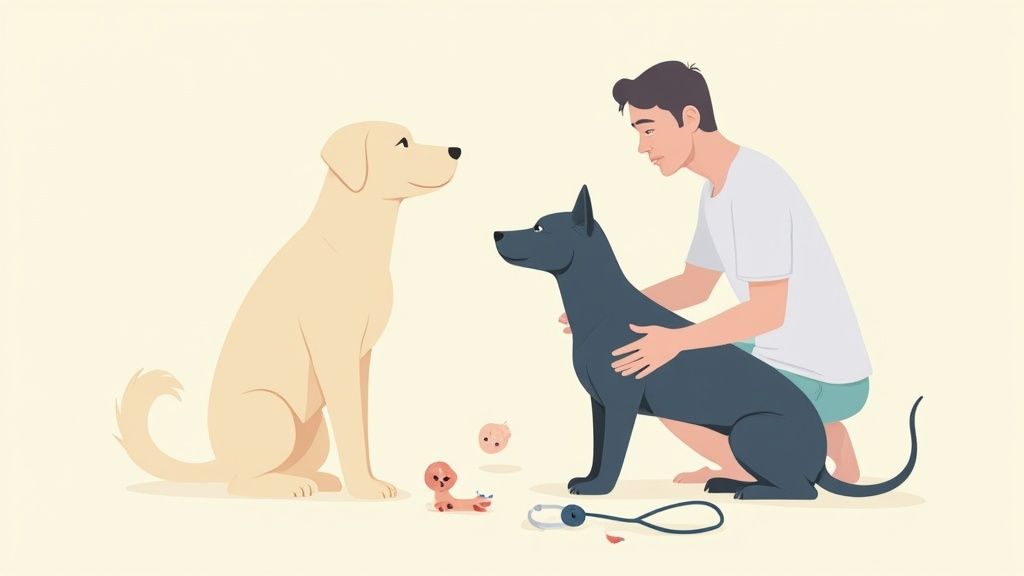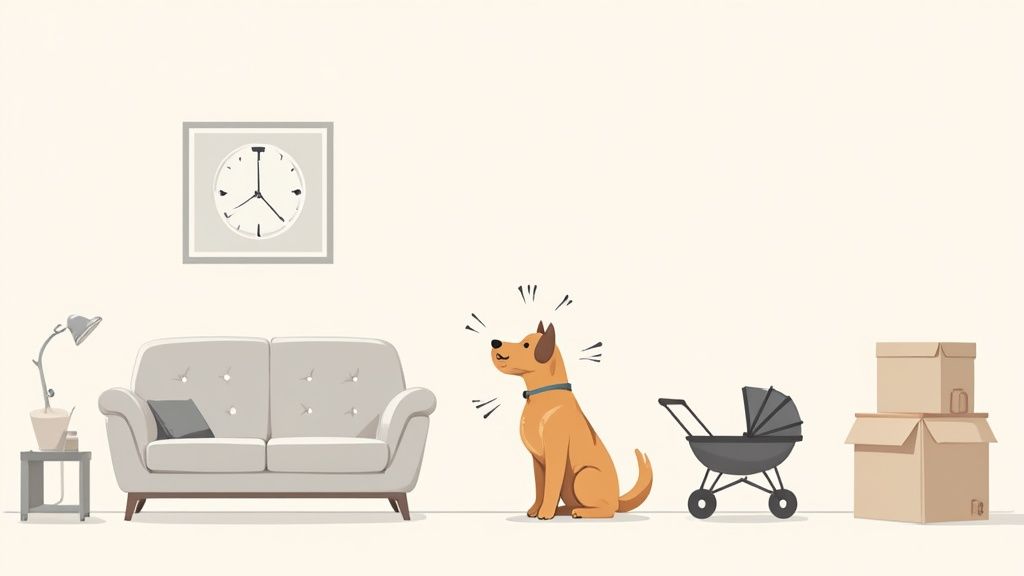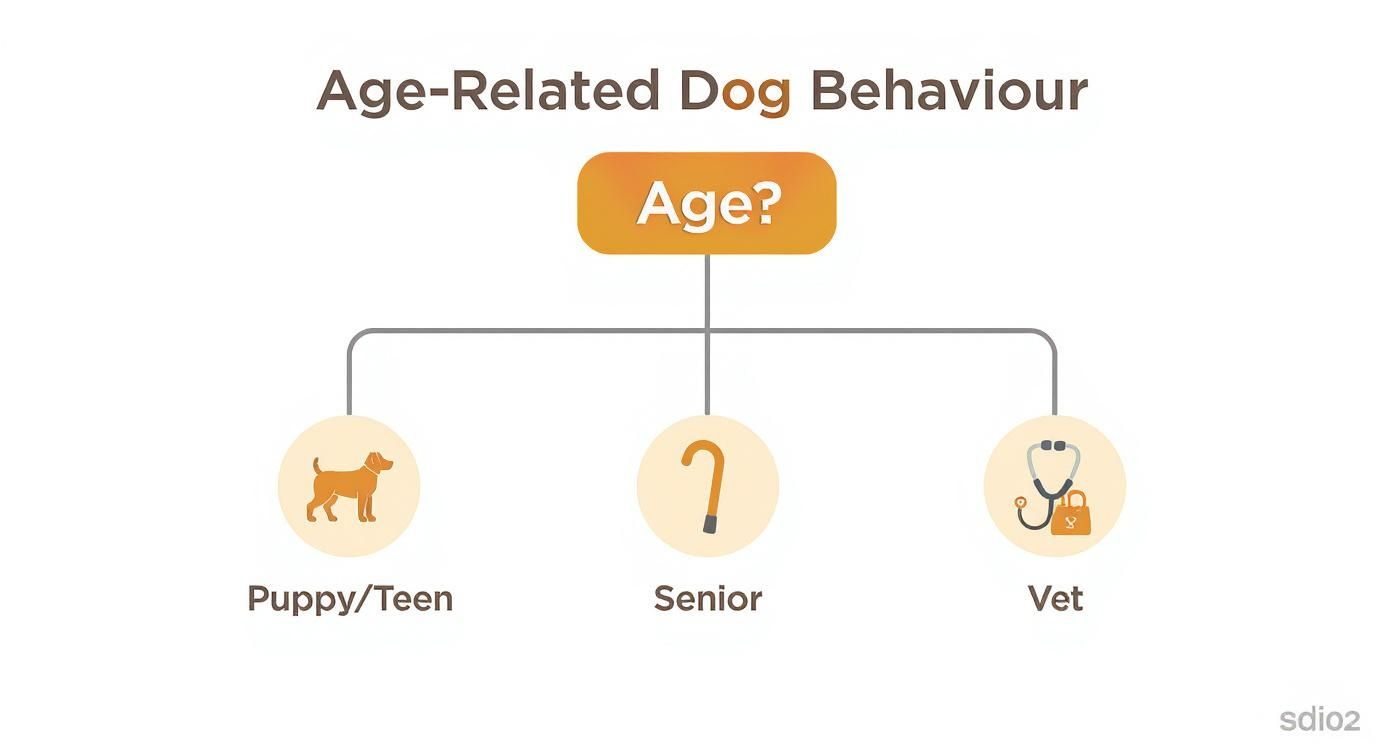A Change in Behavior in Dogs Explained
- ericavdippold
- Oct 24
- 13 min read
When your dog's behavior suddenly goes off-kilter, it's more than just a weird phase—it's usually their way of telling you something isn't right. Since they can't use words, their actions are their voice, and it's our job as their people to listen. Paying close attention to these shifts is the first, most crucial step in figuring out how to help.
Decoding Your Dog's Sudden Behavioral Shifts

Here at the daycare, I’ve seen just about everything. A bouncy, social regular who suddenly won't leave my side, or a quiet pup that starts barking at every little sound. That gut feeling you get—the one where you think, "This just isn't my dog"—is something nearly every owner goes through at some point. It’s confusing, and honestly, it can be pretty worrying.
The key thing to remember is that dogs thrive on routine. They have their favorite nap spots, their preferred walking routes, and their signature happy-to-see-you dance. When these deep-rooted patterns change out of the blue, it’s not for no reason. It’s a message.
Physical vs. Psychological Causes
Think of a sudden change in behavior in dogs as a puzzle. The pieces almost always fit into one of two main categories: physical or psychological. Your job isn't to play veterinarian, but to become a sharp-eyed detective, gathering clues to share with the professionals.
Physical Causes: These are often rooted in pain or illness. A dog with an aching tooth might abruptly stop playing with their beloved chew toy. One with an ear infection might flinch when you try to pet their head or become uncharacteristically irritable.
Psychological Causes: These stem from their emotional state or environment. Major life changes like a move, a new baby joining the family, or even a different work schedule for you can introduce stress and anxiety, which often bubble up as new, unwelcome behaviors.
The single most important thing you can do as a dog owner is to establish a baseline for your dog's "normal." When you know what their typical energy levels, eating habits, and social interactions look like, you'll be the first to spot when something is off.
Learning Their Language
Figuring out why your dog is acting differently always starts with careful observation. Before you can connect the dots, you need to know what you’re even looking for. Dogs are constantly communicating through their posture, the way they hold their tail, and the position of their ears.
To help you get started, we've put together a quick reference table connecting common behaviors to potential underlying issues.
Quick Guide to Behavioral Changes and Potential Causes
Use this table to connect common behavioral shifts to potential underlying causes, helping you identify what to investigate further.
Behavior Change You're Seeing | Possible Physical Causes | Possible Environmental or Psychological Causes |
|---|---|---|
Sudden Aggression or Irritability | Dental pain, arthritis, injury, neurological issue, thyroid problems. | Fear, anxiety, resource guarding, lack of socialization. |
Increased Clinginess or Separation Anxiety | Vision or hearing loss, cognitive decline (in older dogs). | Change in routine, new family member, recent move, boredom. |
Loss of Appetite or Refusal to Eat | Upset stomach, dental disease, internal blockage, serious illness. | Stress, anxiety, dislike of new food, change in environment. |
Inappropriate Urination or Defecation | Urinary tract infection (UTI), kidney disease, diabetes, incontinence. | Separation anxiety, marking territory, fear, changes in the household. |
Hiding or Withdrawal | Pain, illness, injury, feeling unwell. | Fear of loud noises (fireworks, thunderstorms), new people/pets. |
This table is a starting point, not a diagnostic tool. The goal is to help you observe more effectively and gather better information for your vet.
Recognizing these signals is the key to uncovering the root cause. For a more in-depth look, our guide to understanding dog body language can help you become more fluent in what your pup is trying to communicate.
This is all about arming you with foundational knowledge, not about jumping to conclusions. By learning to be a better observer, you can provide your vet or a certified trainer with the specific, detailed information they need to truly help. In the next sections, we’ll explore these causes in more detail, beginning with how to spot the subtle signs of hidden pain.
Recognizing Hidden Pain and Health Problems

If there’s one truth I've learned from working with countless dogs over the years, it's this: they are absolute masters at hiding pain. It’s a primal survival instinct baked into their DNA. In the wild, showing weakness made you a target. That instinct, while useful then, makes it incredibly hard for us to know when they're hurting now.
This is why a sudden change in behavior in dogs so often waves a massive red flag for a hidden health issue. That new grumpiness or a sudden snap when you reach for their collar probably isn't a new "bad attitude." It's far more likely their only way of telling you something is wrong.
Connecting Behavior to Physical Discomfort
I’ve seen it time and time again—what looks like a behavioral problem is really just a symptom of physical pain. A classic example was a sweet Golden Retriever who suddenly became head-shy and would yelp if another dog got too rowdy near his face. His family worried he was developing anxiety, but a quick vet check found a deep, painful ear infection. Once the medicine kicked in, he was back to his happy-go-lucky self.
It's fascinating how specific health problems can lead to very predictable behaviors.
Dental Pain: A dog with a sore tooth might suddenly ignore their favorite chew toys, get picky with their food, or pull away when you try to pet their head. It hurts!
Joint Pain: Arthritis is a huge one, especially in senior dogs. A dog who used to love hopping on the couch for a cuddle might start lying on the floor instead. They may also get irritable when you try to move them because it's genuinely painful.
Stomach Discomfort: Think about how you feel when your stomach is upset. Nausea or digestive issues can make a dog lethargic, withdrawn, and completely uninterested in food. If you're also seeing tummy troubles, our guide on what to do for dog diarrhea and vomiting has some great advice.
Becoming Your Dog's Health Detective
You know your dog better than anyone. That simple fact makes you their most important health advocate. Learning to spot these subtle links between how they feel and how they act is one of the most powerful skills you can have.
Your first move should always be a call to your veterinarian. Before you jump to conclusions about a behavioral issue, you absolutely must rule out any underlying medical causes. This will save you time and money, and more importantly, it stops your dog from suffering in silence.
By paying close attention, you can collect the clues your vet needs to piece the puzzle together. Jot down when the behavior started, what seems to trigger it, and any other little changes you’ve noticed. This simple act of observation can make all the difference in getting them the help they need, fast.
How Your Dog's World Shapes Their Behavior

Once we've made sure a dog isn't in pain or sick, the very next place I look is at their environment. Dogs are creatures of habit, and they find immense comfort in predictability. A change that seems minor to us—maybe you rearranged the living room or started a new work schedule—can feel like a massive earthquake to them, shaking their whole sense of security.
This is often the root of a sudden change in behavior in dogs that has owners totally stumped. A dog’s world is much smaller than ours, and their home is the very center of that universe. Any disruption can easily trigger stress and anxiety, which then bubbles to the surface as new, and often unwanted, behaviors.
Common Life Changes That Can Unsettle a Dog
Try to see your home through your dog's eyes for a moment. They don't understand why things are different, only that the predictable world they knew has been turned upside down. Some of the most common triggers I see in my work include:
Moving to a New Home: This is a big one. Everything is unfamiliar—the sights, the smells, the layout. It can be incredibly overwhelming.
A New Family Member: Whether it’s a new baby, a partner moving in, or even another pet, the social rulebook of the house has just been completely rewritten.
Shifts in Your Routine: If you suddenly start working longer hours or traveling more, your dog feels that absence profoundly. Their daily rhythm is gone.
Your Own Stress: Dogs are little emotional sponges. If you're stressed out, they absolutely pick up on that tension, and it can make them anxious right along with you.
A dog’s environment is so much more than just four walls and a roof; it's their entire world. Seeing how they perceive changes within that world is the first step to figuring out what’s really causing their stress.
The Science Behind Social and Environmental Triggers
The link between a dog's surroundings and its behavior isn't just anecdotal—it's backed by some serious research. A huge 2020–2023 study from the Dog Aging Project looked at over 47,000 dogs and found clear connections.
For instance, the study noted that smaller dogs were often more fearful, while some mixed-breed dogs showed higher aggression levels. It highlights that a dog's actions are a mix of their background and their daily life. You can dive deeper into these insights by reading the full study findings on New Atlas.
What this really tells us is that both a dog's innate traits and their day-to-day experiences are constantly shaping who they are. When you learn to see your home through their eyes, you can start connecting the dots and understand what might be causing them to act out.
Navigating Age-Related Behavioral Changes
There's nothing quite like watching your dog grow up. You get to see them transform from a clumsy, goofy puppy into a wise, loyal companion. But just like with people, getting older brings changes, and a change in behavior in dogs is a natural part of that journey. Knowing what to expect makes all the difference.
Each life stage gives you a different version of your best friend. Puppies are pure, chaotic energy and endless curiosity. Then comes the teenage phase—usually around six to eighteen months—where your perfectly trained pup might suddenly develop selective hearing and start testing every boundary you've ever set. It's frustrating, but it's also completely normal! Your best tools here are patience and consistency.
The Golden Years and Senior Dog Behaviors
As your dog moves into their senior years, the shifts in their personality can be more obvious and, at times, a bit concerning. This is when your role as a careful, loving observer really comes into play. Most of the new behaviors we see in older dogs are directly tied to their changing physical and cognitive health.
So, what does this actually look like? You might notice:
Confusion or Disorientation: Maybe your dog gets "stuck" in a corner, seems lost in a room they've known forever, or forgets a routine they've followed for years. This can be a sign of Canine Cognitive Dysfunction (CCD), which is a lot like dementia in humans.
Increased Anxiety or Irritability: A dog who's losing their sight or hearing can be startled easily, which can look like sudden aggression or grumpiness. They don't hear you coming up behind them, so what you intend as a gentle pat can feel like a sudden shock.
Changes in Sleep Patterns: It's common for senior dogs to flip their schedules. They might sleep more during the day only to become restless, pace, or even bark at night.
Supporting Your Aging Companion
It's so important to remember that these aren't "bad" behaviors—they're symptoms. Your once-fearless companion might now be feeling confused and vulnerable. These age-related shifts are well-documented. In fact, studies show senior dogs over 12 years old often bark more and develop new phobias, which are directly linked to declines in their physical and sensory health. Not wanting to participate in activities they once loved is also a common outcome. You can read more about these age-related findings to get a deeper understanding.
Compassion is your most powerful tool during this stage. Your goal is to create a safe, predictable world for them, which helps manage their anxiety. This can be as simple as sticking to a consistent daily routine, putting a few nightlights in dark hallways, and making sure their bed is extra comfy and easy to get into.
Even small adjustments can have a massive impact. For example, giving an anxious senior dog a secure, cozy den can be incredibly comforting. If you're not sure where to start, our guide on how you can crate train an older dog has gentle, effective steps. But the most important step of all is talking to your vet. They can help you rule out pain or other medical issues that could be behind the new behaviors.
What to Do When You Notice a Change
So, you've put on your detective hat and you're pretty sure something is off with your pup. You might even have a hunch about what's causing the change in behavior in dogs. What now? This is where we shift from observing to acting, creating a clear plan to help your best friend get back on track.
It’s completely normal to feel worried or even a little overwhelmed when your dog isn't themselves. But having a step-by-step approach helps cut through the anxiety and ensures you’re doing everything you can for your furry family member.
Your First and Most Important Step
The very first call you need to make is to your veterinarian. I really can't say this enough. Before you even think about behavioral training, you absolutely must rule out any underlying medical issues. Pain is a massive driver of sudden behavioral shifts, and your vet is the only person qualified to figure that out.
To get the most out of that vet visit, you need to go in prepared. Don't just walk in and say, "My dog is acting weird." Give them the details they need to connect the dots.
Document Everything: Keep a simple log in your phone's notes app. Jot down what the behavior is, when you first noticed it, how often it’s happening, and what seems to trigger it.
Take Videos: A short video clip of the behavior is worth a thousand words. It’s one thing to describe a weird limp or a sudden snap; it’s another thing entirely for your vet to see it for themselves.
List Your Questions: Write down everything you want to ask ahead of time. It's easy to forget things when you're in the exam room.
This visual decision tree can help you map out the next steps, considering key factors like your dog's age.

As you can see, whether you have a young pup or a senior dog, the path almost always leads back to getting some professional guidance.
Knowing When to Call in a Specialist
Okay, so your vet has given your dog a clean bill of health. What's next? This is the point where you bring in a behavior professional. The world of dog behavior experts can be a little confusing, so let's clear it up.
Think of it this way: your vet is like your family doctor. But if you were dealing with a complex psychological issue, your doctor would refer you to a psychiatrist. It's the same idea for dogs.
Here’s a quick breakdown of who does what:
Certified Professional Dog Trainer (CPDT): A trainer is your go-to for teaching new skills and managing common problems like leash pulling, jumping on guests, or basic obedience. They focus on the "how-to" of training and building good habits.
Veterinary Behaviorist (DACVB): This is a veterinarian who has gone through years of specialized, board-certified training in animal behavior. They are the experts for serious issues like deep-seated anxiety, intense phobias, and aggression. Crucially, they can also prescribe medication if it's needed as part of a treatment plan.
The right pro really depends on what your dog is going through. Your own veterinarian is a great resource here—they can usually point you toward a trusted local expert who fits your needs.
Understanding Your Dog's Breed Instincts
While every dog is an individual with their own quirks, we can't ignore the powerful role their heritage plays in who they are. The best way to think about a dog's breed is like an ancestral job description. For hundreds, sometimes thousands, of years, humans specifically bred dogs for certain tasks. Those powerful instincts don't just vanish because your dog's main job is now warming your couch.
This history gives us incredible context for a sudden change in behavior in dogs, or even for behaviors that have been there all along. Is your Border Collie suddenly trying to "herd" your kids around the living room? They aren't being a pint-sized tyrant; they're acting on a deep-seated instinct to create order. A Beagle who goes deaf to your calls the second their nose hits an interesting scent isn't being stubborn—they're doing the exact thing they were created to do.
From Instinct to Action
These genetic blueprints often explain behaviors that leave us scratching our heads. When those natural urges don't have a healthy outlet, they can easily spill over into anxiety, destructive habits, or other problem behaviors.
Terriers: Bred to hunt and dig for vermin, they might channel that drive into excavating your prize-winning petunias or barking with single-minded focus at a squirrel.
Hounds: Whether they hunt by sight or scent, these dogs often have a very strong prey drive and an independent streak, which can make a reliable recall a serious training challenge.
Retrievers: Their whole purpose was to gently carry game back to a hunter. This is exactly why they often have a "soft mouth," love to carry toys (or your shoes) around, and tend to be naturally social.
This isn't about pigeonholing your dog based on their breed. It's about appreciating the rich history that shaped them and understanding their needs on a much deeper level. Knowing what your dog was originally meant to do is the key to providing the right kind of enrichment.
This history doesn't just shape our dogs; it shapes what we look for in them. A fascinating study of breed registrations in the U.S. from 1926 to 2005 revealed a clear pattern. Retrievers, famous for their trainability and low aggression, saw a steady climb in popularity. This suggests we've increasingly valued sociable, obedient dogs as family companions over the decades. You can find more details about these breed popularity trends on PMC.
Common Questions About Dog Behavior Changes
Here at the daycare, I get asked a lot of the same questions by loving, worried owners. When you notice a change in your dog, it's natural for your mind to race. I've gathered a few of the most common questions I hear to give you some quick, clear answers.
Why Has My Well-Behaved Dog Suddenly Started Acting Out?
When a dog that's usually a perfect angel suddenly starts acting out, it's a huge red flag. My first thought is almost always pain. Dogs are masters at hiding discomfort, and a change in behavior is often the only clue they give us.
Think about the things you can't see, like a throbbing toothache, an aching joint from early arthritis, or even a brewing infection. It could also be a reaction to a big life change that's causing them stress. Your first, non-negotiable step is always a thorough vet check-up to get to the bottom of it.
Can My Dog’s Diet Cause a Behavior Change?
Yes, absolutely! What goes into your dog’s bowl has a massive impact on how they feel and act. A new food that doesn't agree with their system can easily cause stomach upset, making a dog grumpy, restless, or just plain miserable.
Some studies have even explored links between specific food ingredients and issues like hyperactivity. If the behavior change lines up with a recent switch in their food, it’s a conversation worth having with your veterinarian.
Your vet can help you pinpoint if an allergy, an intolerance, or even a nutritional imbalance might be the real culprit.
Is My Dog's New Aggression Just a Phase?
This is a dangerous assumption to make. Please don't ever assume aggression is "just a phase" that a dog will outgrow. Aggression is communication—it's your dog's way of screaming that they are scared, in pain, or feeling threatened.
Ignoring it doesn't make it go away; it almost always makes the situation worse.
Any new or escalating aggression needs immediate and careful attention.
Step One: Get to your vet right away to rule out any underlying medical causes.
Step Two: Find a certified professional, like a veterinary behaviorist or a certified dog trainer, to help you safely manage the behavior and figure out what’s driving it.
At Pawcation, we're here to provide a safe, fun, and loving environment for your best friend. If you need a trusted partner for daycare or boarding, we'd love to welcome your pup into our family. Learn more about our services.
Comments